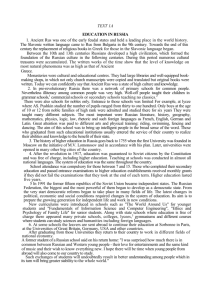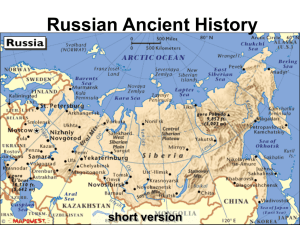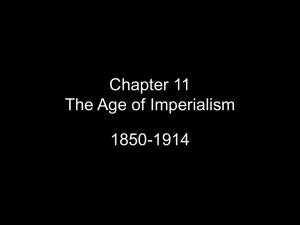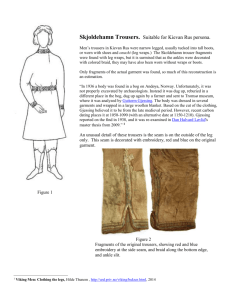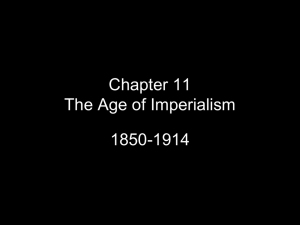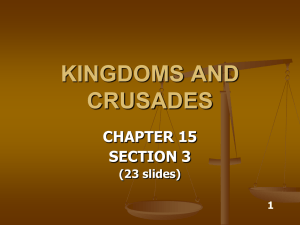here - University of Washington
advertisement
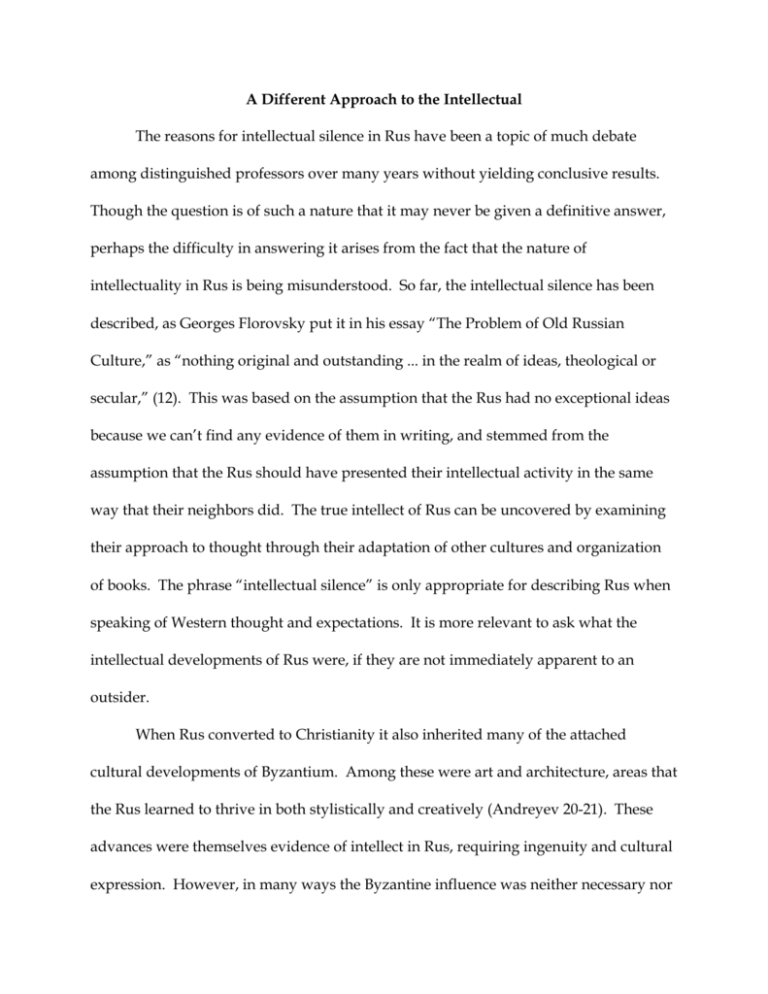
A Different Approach to the Intellectual The reasons for intellectual silence in Rus have been a topic of much debate among distinguished professors over many years without yielding conclusive results. Though the question is of such a nature that it may never be given a definitive answer, perhaps the difficulty in answering it arises from the fact that the nature of intellectuality in Rus is being misunderstood. So far, the intellectual silence has been described, as Georges Florovsky put it in his essay “The Problem of Old Russian Culture,” as “nothing original and outstanding ... in the realm of ideas, theological or secular,” (12). This was based on the assumption that the Rus had no exceptional ideas because we can’t find any evidence of them in writing, and stemmed from the assumption that the Rus should have presented their intellectual activity in the same way that their neighbors did. The true intellect of Rus can be uncovered by examining their approach to thought through their adaptation of other cultures and organization of books. The phrase “intellectual silence” is only appropriate for describing Rus when speaking of Western thought and expectations. It is more relevant to ask what the intellectual developments of Rus were, if they are not immediately apparent to an outsider. When Rus converted to Christianity it also inherited many of the attached cultural developments of Byzantium. Among these were art and architecture, areas that the Rus learned to thrive in both stylistically and creatively (Andreyev 20-21). These advances were themselves evidence of intellect in Rus, requiring ingenuity and cultural expression. However, in many ways the Byzantine influence was neither necessary nor helpful in the development of intellectual expression in Rus. Florovsky suggests that Byzantium offered too much to the Rus at once and that not all of it could be absorbed (13). Perhaps a more accurate interpretation would be that not all the aspects of Byzantine culture were conducive to Russian intellectual voice. The Igor Tale, despite originating in a Christian nation, uses many pagan references as literary devices, calling the Rus “Dahzbog’s Grandchildren” and using animals common in Russian folklore as symbols (“Igor”; Haney). This shows that, though ultimately representing God’s power, the author of the tale didn’t have adequate tools from Christian Byzantine literature to express his ideas in the form of quality literature. Thus, the Rus took from Byzantium what they could use and stuck to their old traditions where it was the best outlet for expression. This utilization of the useful aspects of Byzantine culture is reflected in many significant texts from the Kievan period. Hilarion’s “Sermon on Law and Grace” describes how the law comes before grace and truth and cites as example the coming of the law through Moses, followed by the coming of grace with Jesus (“Law,” 87). A parallel can be seen in history with Byzantine Christianity as the law and the Russian interpretation and integration as grace. This shows that Rus didn’t just accept outside cultures blindly, but rather fit the relevant parts into their own traditions. It would be unfair to expect the Rus to adapt Byzantine culture entirely and to express their ideas in the same way. The Rus drew from many different cultural influences besides Byzantium. Florovsky explains that, “Kievan Russia was not isolated from the rest of the Slavic world, as it was not separated from Byzantium and the West, or from the East,” (7). This contradicts Nikolay Andreyev’s assertion that the Rus were cut off from the West by the Mongols (21). However, Florovsky’s argument is more realistic because Novgorod and Galich weren’t destroyed and trade didn’t cease (Andreyev, 20). Also, many princes and princesses married outside of Rus, making Polovtsian, European, and Byzantine connections (Waugh, “Regional”). This collection of cultural sources that the Rus drew on is reflected in the number of sources that were used when making books in the Chetii Sborniki category, as William R. Veder described them in his “Old Russia’s ‘Intellectual Silence’ Reconsidered.” These books are disorganized, containing excerpts from different sources in a seemingly random order. Veder suggests that these texts “may function merely ‘as its catalyst,’ or as ‘a kind of reminder,’” and that the reader “’is not only a listener, he is a creator,’” (5). Thus the seemingly disorganized, limited, and rare books of Kievan Rus could have really been tools to stimulate thought, rather than the misunderstood copies of an underdeveloped literacy. This practice of drawing on old, respected texts shows that the Rus valued their past and the ideas of their ancestors. Instead of writing lots of new texts, the Rus reinterpreted their old favorites. The practice of finding new interpretations for old texts is related to the artistic custom of copying divinely inspired icons (Waugh, “Christian”). Rather than writing and circulating new texts, the old were kept and recopied, though often only partially, out of order, and combined with other texts. Readers could interpret the revered texts in a different way every time they read, but the material was the same. The Chronicle quotes the Bible in many places, giving interpretation to an excerpt by connecting it with an event. When Vladimir converts to Christianity, the Primary Chronicle asserts that this “fulfilled in the Russian land the prophecy which says: ‘In those days, the deaf shall hear words of Scripture, and the voice of the stammerers shall be made plain,’” (“Chronicle” 71). This passage from their translated Bible was not written with the conversion of the Rus in mind, but nevertheless, its application here gives it a new meaning. Hilarion also brought new meaning to a Bible passage when he connected the story of Abraham, Sarah, and Hagar to his message about law and grace (87). Thus old texts were given new life through different intellectual interpretations. Quoting texts to support a point is an aspect of intellectual debate that we use even today in scholastic writing. The texts from Rus mostly quote the Bible, but even this shows that they had some concept of structure similar to the ideals of the West. In his “Instruction,” Vladimir Monomakh supported the points that he made about being good Christians with many Bible passages, showing his extensive knowledge of the psalms (“Monomakh” 94-96). This doesn’t necessarily mean that Monomakh could read and write because he could have memorized the Psalms and dictated his “Instruction.” However, the fact that he mentions reading his psalter and then copying the passage is strong evidence that he could do both. Nevertheless, the uncertainty of his literacy shows that it was not necessary in order to have a knowledge of the Bible and interpret it. Knowledge was transported throughout Rus even when many people were not literate. According to Alexander N. Konrad, pilgrimages to Jerusalem and Constantinople were common by the eleventh century. Even the blessed Theodosius wanted to follow the pilgrims and see the holy places, against the will of his mother (“Theodosius” 121). These people “were often considered synonymous or closely comparable with heroic figures,” and “were in a favorable position of being able to communicate knowledge otherwise accessible only to the limited group of the educated,” (Konrad, 8). This shows that the pilgrims served to spread knowledge where books and literacy could not. As seekers and spreaders of knowledge, they were respected and even treated as heroes, showing that the Rus valued wisdom. It also implies that the pilgrims were the Russian version of the West’s intellectuals. This interpretation shows that the Russian intellect was one of active, physical searching and the spread of knowledge orally and through stories of experiences. Of course, this was not the only method employed, but it seems to be the best for relating to the masses. Despite their rarity, books were very important and valued by the Rus. The Primary Chronicle praises Yaroslav the Wise because he “wrote and collected many books through which true believers are instructed and enjoy religious education,” (“Chronicle” 72). This shows that books were used and respected among the princes and clergy, since a member of the church probably wrote this passage. Konrad explained that later Church lists of apocrypha testify that “’these heretical works were often saved by their readers, preserved in thick volumes in village libraries, and distributed to readers at large, many of whom were themselves members of the clergy,’” (5). The mention of the village library shows that eventually the greater public had access to books and their knowledge. Access to books would not necessarily mean that they were widely read. One reason that thought and the spread of knowledge are not obvious in medieval Russia is that “every attempt to lean on the secular sciences and education was considered heresy,” (Konrad, 3). Also, literacy was not “stimulated by any specific needs or requirements, whether juridical, commercial, administrative, political, or “feudal”... or in the habits of thought,” (Franklin, 38). Thus writing was neither necessary for the spread of ideas nor appropriate for the task, considering the views of the Church. At first glance Rus may seem to have an “intellectual silence” to our minds trained in Western thought, but if we listen carefully we will see that this is not true. The intellectual noise of Rus is in most cases not written, but the thought-stimulating arrangement of the books of the elite as well as the popularity of the apocrypha among the masses show that intellect was alive. The pilgrims to the holy lands served as conveyors of knowledge as they searched for meaning and became the Russian equivalent to the Western intellectual. Despite the Church’s power, there is still evidence of pagan traditions, especially where the cultural offerings of Byzantium were not adequate for Russian expression. Thus there is evidence of weak intellectual activity among the Rus, even if there is little to no output. There is enough here to make it inappropriate to speak of the “intellectual silence” of Rus, though further investigation needs to be made into just how “loud” the intellectual noise of Rus was. Certainly, their lack of written intellectual material makes their communication of ideas with the outside world practically nonexistent, so if “intellectual noise” is defined as what outsiders hear, then Rus was exceedingly “soft.” However, if “intellectual noise” is valued by its uniqueness, the Rus were at a high level. By not simply accepting complete, pre-made culture from Byzantium or its other connections, Rus showed that it was original. Also, by becoming literate but not relying on writing for the purposes of government and circulation of ideas, the Rus showed that they had a memory oriented intellect rather than a written one. This approach is in some ways better, since they were not dependent on books to think and learn. The Rus were intellectually softspoken, so the noise they made deserves careful listening rather than dismissal. Works Cited Andreyev, Nikolay. “Pagan and Christian Elements in Old Russia.” Slavic Review, Vol. 21, No. 1. (Mar., 1962). 16-23. JSTOR. University of Washington Libraries. 27 October 2004. <http://links.jstor.org/sici?sici=0037-6779%28196203%2921%3A1 %3C16%3APACEIO%3E2.0.CO%3B>. “Commentary” Trans. J. A. V. Haney and Eric Dahl. Russian 321. 1992. 21 October 2004. <http://faculty.washington.edu/dwaugh/rus/texts/igorcm.htm>. Florovsky, Georges. “The Problem of Old Russian Culture.” Slavonic Review, Vol. 21, No. 1. (Mar., 1962). 1-15. JSTOR. University of Washington Libraries. 27 October 2004. <http://links.jstor.org/sici?sici=0037-6779%28196203%2921%3 A1%3C1%3ATPOORC%3E2.0.CO%3B2-%>. Franklin, Simon. “Literacy and Documentation in Early Medieval Rus.” Speculum, Vol. 60, No. 1. (Jan., 1985). 1-38. JSTOR. University of Washington Libraries. 27 October 2004. <http://links.jstor.org/sici?sici=0038-7134%28198501 %2960%3A1%3C1%3ALADIEM%3E2.0.CO%3B2-S>. Konrad, Alexander N. “Forbidden Literature in Old Russia: Its Rivalry with “Holy” Writings.” Russian 321. 1972. 21 October 2004. <http://faculty.washington. edu/dwaugh/hstam443/materials/texts/konrad.html>. “On Igor’s Campaign.” Trans. J. A. V. Haney and Eric Dahl. Russian 321. 1992. 21 October 2004. <http://faculty.washington.edu/dwaugh/rus/texts/ igortxt2.htm#3>. “Life of our Blessed Father Theodesius, Abbot of the Crypt Monastery.” Zenkovsky 116-134. “Metropolitan Hilarion: Sermon on Law and Grace.” Zenkovsky 85-90. “Stories From the Primary Chronicle.” Zenkovsky 43-77. Veder, William R. “Old Russia’s ‘Intellectual Silence’ Reconsidered.” California Slavic Studies. XIX (1994): 18-28. 27 October 2004. <http://faculty.washington.edu/ dwaugh/hstam443/materials/texts/veder.html>. “Vladimir Monomakh: Instruction to his Children.” Zenkovsky 92-100. Waugh, Daniel C. ”The Origins of Byzantine Christian Iconography.” Russian 321. 2000. 21 October 2004. <http://faculty.washington.edu/dwaugh/hstam443/materials/art/xticon.htm> . ---. ”Regional Centers.” Raitt 121, Seattle. 25 October 2004. Zenkovsky, Serge A., ed. Medieval Russia’s Epics, Chronicles, and Tales. Harmondsworth, England: Penguin Group, 1963.
